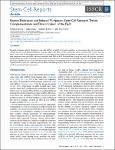Human Embryonic and Induced Pluripotent Stem Cell Research Trends: Complementation and Diversification of the Field
Kobold, Sabine
Guhr, Anke
Kurtz, Andreas
Löser, Peter
Research in human induced pluripotent stem cells (hiPSCs) is rapidly developing and there are expectations that this research may obviate the need to use human embryonic stem cells (hESCs), the ethics of which has been a subject of controversy for more than 15 years. In this study, we investigated approximately 3,400 original research papers that reported an experimental use of these types of human pluripotent stem cells (hPSCs) and were published from 2008 to 2013. We found that research into both cell types was conducted independently and further expanded, accompanied by a growing intersection of both research fields. Moreover, an in-depth analysis of papers that reported the use of both cell types indicates that hESCs are still being used as a “gold standard,” but in a declining proportion of publications. Instead, the expanding research field is diversifying and hESC and hiPSC lines are increasingly being used in more independent research and application areas.
Dateien zu dieser Publikation
Keine Lizenzangabe

